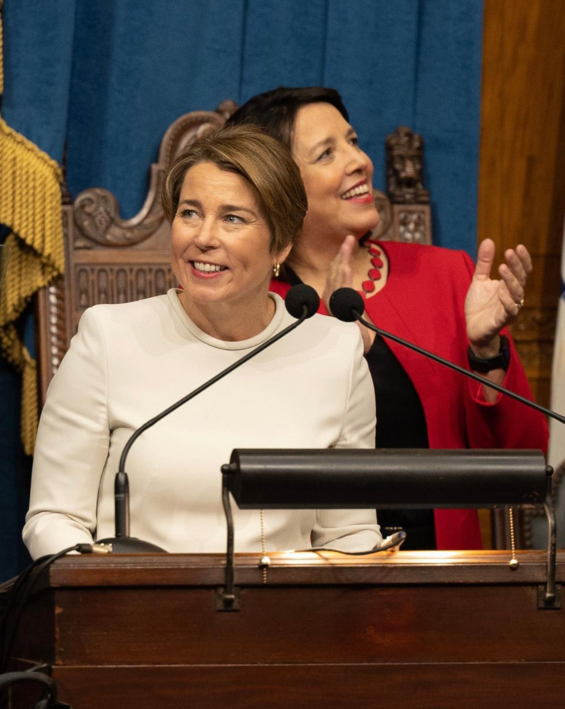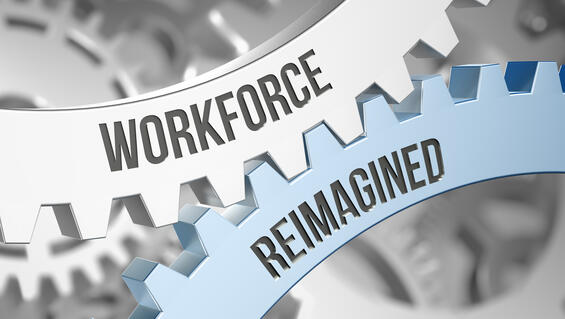Introduction

Governor Maura Healey and Lieutenant Governor Kim Driscoll are two leaders dedicated to advancing opportunities for workers, ensuring employers have the skilled workforce they need to succeed, and lifting all regional economies to drive competitiveness, affordability, and equity across Massachusetts.
When Governor Healey and Lieutenant Governor Driscoll were sworn into office on January 5, 2023, Massachusetts, and the nation experienced historic firsts—the first woman-elected governor in Massachusetts, the first openly lesbian governor in the country, and the first women-led duo to govern the Commonwealth of Massachusetts. This wave of new leadership in Massachusetts signaled the importance of ensuring greater equity in both government and communities statewide. In its first year as a new team, the Healey-Driscoll Administration recognized the opportunity and urgency to meet this moment.
Building on this foundation, the Healey-Driscoll Administration understands how critical the state’s workforce is and will be to fuel economic prosperity in Massachusetts. Now more than ever, Massachusetts will benefit from a strategic workforce agenda that identifies priorities, goals, and strategies to attract, retain, and develop talent while also fostering an innovative, collaborative, and equitable workforce system. Massachusetts’ Workforce Agenda: Meeting the Moment to Attract, Retain, and Develop a Future Workforce details a comprehensive plan defined by four focus areas:
- Talent Attraction and Retention
- Talent Development
- Leadership by Example
- Workforce System Infrastructure
In recent years, the workforce has dramatically changed in Massachusetts, nationally, and globally. Described in Massachusetts’ 2023 Economic Development Plan, the global pandemic reset economies at all levels, impacting industries and workforce demands. An increasingly mobile, remote, and hybrid workforce combined with accelerated technology, increased costs, downsized workplaces, shifts in downtown districts, importance on mental health, access, and costs for quality caregiving, and so many more factors continue to evolve and have adjusted the needs for both workers and employers.
In the aftermath of the global pandemic, the Massachusetts labor market increasingly tightened as workers and jobseekers left the labor market, remained disconnected from the workforce, and felt discouraged from re-entering the labor market due to several barriers to access meaningful employment. Today, persistent inequities exist in the Massachusetts labor market based on race, ethnicity, gender, gender identity, class, economic status, physical and mental ability, geography, religion, and veteran status. At the same time, employers across all industries have and continue to face urgent needs to attract, retain, and develop talent to meet hiring demands today and projected over time. Massachusetts’ Workforce Agenda includes an economic analysis section with detailed workforce trends.
Nevertheless, the Healey-Driscoll Administration and the Commonwealth of Massachusetts believe in the power of its people and the strength of its diverse workforce. The greatest asset in Massachusetts is the collection of skills, talents, and efforts by every resident. Moreover, every individual should have the opportunity to contribute to the state's workforce and be rewarded fairly and equitably. The Healey-Driscoll Administration is dedicated to addressing disparities in the state’s workforce and workforce system by creating a labor market that is inclusive, fair, and representative of the diversity of Massachusetts. The strength of the state’s economy is its workforce. Massachusetts has and will thrive when its workers are connected to opportunities that will influence innovation and empower economic growth for employers representing all industries.
There are over 242,000 active job postings that remain unfilled (as of November 2023), and all sectors of the economy are projected to increase employment by 2030. High-growth industries such as the life sciences, healthcare and human services, clean energy, and advanced manufacturing are among the industries with the greatest demands and opportunities statewide. Additionally, regional workforce partners from the Berkshires to the Cape and Islands have partnered with the Healey-Driscoll Administration to examine industries and occupations in greatest need to close the workforce skills gaps and build the workforce local economies need to thrive.
Massachusetts must meet this moment by increasing access and opportunity for residents and new arrivals including untapped and future talent. By leveraging key goals and strategies outlined in Massachusetts’ Workforce Agenda, the Commonwealth will unlock greater equity, create pathways and skill building to meet demands, and ensure Massachusetts’ workers and rising talent are positioned for success and skilled to fill the thousands of jobs available today and projected for the future.
The US Department of Labor’s (USDOL) 2024-2028 Workforce Innovation Opportunity Act (WIOA) State Combined Plan served as an opportunity for the Healey-Driscoll Administration including the MassHire State Workforce Board, the Executive Office of Labor and Workforce Development, and partnering state agencies to engage stakeholders and communities and prioritize goals, identify effective strategies, and enhance collaborations to create a workforce development roadmap for the next four years. Massachusetts’ Workforce Agenda and the more detailed Workforce Innovation and Opportunity Act (WIOA) State Plan reflect the Healey-Driscoll Administration’s first workforce agenda, incorporating equity, competitiveness, and affordability combined with measurable goals to develop a skilled workforce to benefit workers and employers, and in turn, strengthen Massachusetts’ economic prosperity.
Purpose
Massachusetts’ Workforce Agenda: Meeting the Moment to Attract, Retain, and Develop a Future Workforce serves as the Healey-Driscoll Administration’s first workforce agenda, which contributes directly to the more detailed and comprehensive USDOL 2024-2028 WIOA State Plan (WIOA State Plan).
The WIOA State Plan sets forth the workforce agenda for the Healey-Driscoll Administration, reflecting the Governor and MassHire State Workforce Board’s vision, mission, goals, and strategies in collaboration with workforce partners. Intended to benefit the Commonwealth’s workforce system, the WIOA State Plan:
- Acts as a framework for major public workforce system partners, including WIOA partners, on operations, coordination, and new strategies;
- Represents over $400 million in state and federal funding across partners;
- Outlines the synergy between state and local partners by articulating the coordination of services across and between agencies including the Executive Office of Labor and Workforce Development, the Department of Career Services, the Department of Unemployment Assistance, the MassHire system, the Executive Office of Health and Human Services, the Department of Transitional Assistance, Massachusetts Rehabilitation Commission, Massachusetts Commission for the Blind, the Executive Office of Veterans Services, the Executive Office of Elder Affairs, the Executive Office of Education, the Department of Elementary and Secondary of Education including its Adult and Community Learning Services Department, the Executive Office of Public Safety and Security, and the Department of Corrections, among collaborators statewide; and
- Builds consensus and focus across stakeholders in a workforce ecosystem that is a complex combination of federal and state programming.

Vision and Mission Statement

The MassHire State Workforce Board is comprised of members appointed by the Governor and representing business, labor, academia, elected officials, and community and workforce partners across the Commonwealth. The MassHire State Workforce Board advises the Governor on building an effective workforce system. In the development of Massachusetts’ Workforce Agenda and WIOA State Plan, the Board established a vision and mission statement to guide the work and remain accountable to the details outlined in the plan.
Vision Statement prepared by the MassHire State Workforce Board
To be a collaborative workforce system that prepares a skilled workforce that employers need, promotes access to good jobs, and creates an equitable and inclusive economy.
Mission Statement prepared by the MassHire State Workforce Board
The Massachusetts workforce system strives to reduce barriers to employment, increase labor market participation, and supports and develops programs to deliver good jobs, skilled workers to meet industry demand, and an equitable and inclusive economy statewide and in regions across the Commonwealth.
Focus Areas
Building on the MassHire State Workforce Board’s vision and mission, the Healey-Driscoll Administration’s Workforce Agenda and WIOA State Plan includes four focus areas:
Focus Area I: Talent Attraction and Retention
For the Commonwealth to be a leader in attracting and retaining talent, Massachusetts must reduce barriers to employment as a critical strategy that will increase labor market participation, especially among underrepresented and underserved populations, and foster a more equitable workforce.
Focus Area II: Talent Development
As Massachusetts invests in talent pipelines and career pathways for residents, it is imperative that workforce strategies align with industry hiring demands expressed by employers today, and projected by employers for future in-demand occupations across the state.
With the goal of strengthening Massachusetts’ talent pipelines, a collaborative workforce system needs to prepare future talent and create upskilling pathways for workers through effective education and training models that will fuel priority industries and occupation.
Focus Area III: Leadership by Example
Massachusetts has a tremendous opportunity to strengthen and scale effective strategies, programming, and resources to develop untapped talent especially with the Governor and Executive Branch leading by example, and the Commonwealth as the largest employer in Massachusetts.
Focus Area IV: Workforce System Infrastructure
Massachusetts needs to modernize and strengthen the infrastructure and coordination across the MassHire public workforce system to improve support for jobseekers and employers. Additionally, as the MassHire State Workforce Board serves as a convening body to influence and support Massachusetts’ Workforce Agenda, the Board should also ensure alignment as a resource for the Executive Office of Labor and Workforce Development to engage Board members, regional workforce partners, and more.


Stakeholder Engagement
The Healey-Driscoll Administration and MassHire State Workforce Board engaged with internal and external partners across Massachusetts. Beginning in the spring of 2023, engagement helped to form the foundation for the vision, mission, goals, and strategies outlined in Massachusetts’ Workforce Agenda and WIOA State Plan.
Building on Massachusetts’ WIOA State Plan partners, stakeholders spanned multiple organizations to incorporate feedback that ultimately shaped strategies to attract, retain, and develop talent in Massachusetts and strengthen the state’s workforce infrastructure systems.
WIOA State Partners Advisory Committee (SPAC):
- Executive Office of Labor and Workforce Development (EOLWD)
- MassHire Department of Career Services (DCS)
- Director of Multilingual Services, EOLWD
- Department of Unemployment Assistance (DUA)
- MassHire DCS Jobs for Veterans State Grant Director
- Executive Office of Veterans Services (EOVS)
- Executive Office of Education (EOE)
- Department of Elementary and Secondary Education’s Adult Education
- Commonwealth Corporation
- Executive Office of Public Safety and Security (EOPSS)
- Department of Corrections
- Executive Office of Health and Human Services (EOHHS)
- Department of Transitional Assistance (DTA)
- Massachusetts Rehabilitation Commission (pending name change to MassAbility)
- Massachusetts Commission for the Blind
- Executive Office of Elder Affairs
Workforce Skills Cabinet:
- Executive Office of Labor and Workforce Development
- Executive Office of Education
- Executive Office of Economic Development (EOED)
- Executive Office of Health and Human Services
MassTalent:
- Executive Office of Labor and Workforce Development
- Executive Office of Education
- Executive Office of Economic Development
- Executive Office of Health and Human Services
- Executive Office of Energy and Environmental Affairs (EOEEA)
- Governor’s Office of Climate Innovation and Resilience
- Massachusetts Clean Energy Center
- Commonwealth Corporation
- Massachusetts Life Sciences Center
- Massachusetts Technology Collaborative
Regional Workforce Partners:
As part of the Workforce Skills Cabinet, seven regional sessions were convened in the fall of 2023 bringing together representatives from workforce development, academia, business, labor, and elected office. Regions included:
- Berkshires
- Pioneer Valley
- Central
- Northeast
- Greater Boston
- Southeast
- Cape Cod and Islands
Curated Conversations:
- Labor and Registered Apprenticeship Pathways and Pipelines, hosted by Massachusetts AFL-CIO
- Youth Employment, hosted by Massachusetts Workforce Association
- Diversity, Equity, and Inclusion in the Workplace, hosted by The Partnership
- Caregiving in the Workplace, hosted by Massachusetts Business Roundtable
- Partnerships with Community Colleges, hosted by Massachusetts Association of Community Colleges
- Partnerships with Chambers of Commerce, hosted by Massachusetts Chambers of Commerce Policy Network
Policy Papers and Recommendations:
- Recommendations of the Climate Chief (Governor’s Office of Climate Innovation and Resiliency)
- TeamMA: Leading Future Generations – Economic Development Plan (Executive Office of Economic Development)
- Tapping Untapped Talent: How Foreign-Educated Immigrants Can Strengthen the Massachusetts Economy (Massachusetts Business Roundtable and Tufts University Center for State Policy Analysis)
- Equitably Addressing the Workforce Crisis in MA: How to Capitalize on Minority-Serving Institutions (Massachusetts Taxpayers Foundation and Massachusetts Business Roundtable)
- Lifting our Communities: Building Education Pathways to Economic Opportunity for All (Massachusetts Business Alliance for Education)
- Among others!
The Healey-Driscoll Administration also facilitated a public comment period through virtual, open discussions from late January to early February 2024 to finalize the Massachusetts Workforce Agenda and WIOA State Plan.
Detailed Strategies
Increasing access and opportunity for Massachusetts residents and new arrivals is critical in attracting, retaining, and developing the talent industries and employers need today and for the Commonwealth’s future. Massachusetts can meet this moment by building on a collaborative workforce system to leverage key goals and strategies outlined in Massachusetts’ Workforce Agenda and WIOA State Plan. In turn, these partnerships and strategies will further position Massachusetts to unlock greater equity, create pathways and skill building to meet demands, and ensure Massachusetts’ workers and rising talent are positioned for success and skilled to fill the thousands of jobs available today and projected for the future.
Goals and strategies are outlined in four focus areas including: I) Talent Attraction and Retention, II) Talent Development, III) Leadership by Example, and IV) Workforce System Infrastructure.
I. Talent Attraction and Retention
Massachusetts must reduce barriers to both employment and hiring to increase labor market participation and foster a more equitable workforce to drive talent attraction and retention for both jobseekers and employers across the Commonwealth.
Key Strategies:
- Strengthen work supports: Launch a stipend initiative for low-income participants in sector pathway models to incentivize enrollment, completion, and employment and reduce barriers to training and employment (such as costs for caregiving, transportation, digital access and equipment, and more).
- Increase access to transportation to work: Connect jobseekers and workers via MassHire career centers to local transportation or provide limited WIOA subsidies for transportation to and from work.
- Reduce the cliff effect: Implement a statewide project to address cliff effects, initiating first with a pilot to reform benefit disincentives and provide economic mobility for participants.
- Subsidize housing costs: Refer job seekers accessing MassHire career centers to local housing assistance organizations. Additionally, provide support for individuals in shelter to gain employment as a catalyst to exit shelter.
- Increase worker retention: Promote the Workforce Training Fund for eligible employers to reskill or upskill incumbent workers and as a hiring and retention strategy. For employers who may not be eligible to access grants from the Workforce Training Fund, explore other grant programs through the Workforce Competitiveness Trust Fund to support reskilling or upskilling incumbent workers.
- Promote ESOL for work: Leverage Workforce Training Fund grants for employers to increase use for ESOL training among incumbent workers and as a hiring and retention strategy.
- Incorporate a whole-of-government approach to caregiving: Work collaboratively across government, including the Executive Offices of Education, Economic Development, and Labor and Workforce Development among other agencies to take a “whole-of-government” approach to ensuring affordable, high-quality child care in Massachusetts as outlined in an Executive Order signed by Governor Healey on January 16, 2024. Additionally, the Executive Office of Labor and Workforce Development will partner with the Massachusetts Caregivers Coalition with a renewed focus on increasing awareness of child care, senior care, and other caregiving resources in the workplace.

II. Talent Development
Massachusetts has an opportunity to strengthen and scale effective strategies, programming, and resources to develop untapped talent to meet the hiring needs of employers. By focusing on talent development, Massachusetts is positioned to lead through this strategy with defined approaches to:
- Support Priority Populations
- Promote Targeted, High-Growth Industries and Employer Needs
- Address AI and the Future of Work
Support Priority Populations
As part of a talent development strategy, Massachusetts needs to create programming and pathways to move people off the sidelines and into the labor market. This approach should especially consider priority populations including discouraged, underemployed, and unemployed residents, as well as individuals disconnected from the Massachusetts labor market.
Key Strategies:
1. Youth: Support, scale, and align state programming for youth through greater coordination across WIOA Youth services, the Connecting Activities program, and the YouthWorks program to scale youth employment and supports.
The YouthWorks program expanded rapidly post-COVID, providing employment for participants between 14 and 25 years old who identify as lesbian, gay, bisexual, transgender, queer and questioning, youth of color, youth of all abilities, national origins and religions and low-income youth, including single income households, youth who are experiencing housing insecurity, and other youth determined to be eligible by the Commonwealth Corporation.
To address the changing funding landscape for Youthworks, EOLWD will work with partners to:
- Sync Work-Based Learning Plan with Signal Success curriculum
- Coordinate business outreach across YouthWorks, Connecting Activities, and STEM
- Establish a single state website for employers and youth and young adults for internships
- Partner to support education’s “Reimagine High Schools” campaign to strengthen K-12 opportunities that integrate work and learning
2. Immigrants and New Arrivals: Support immigration employment opportunities for immigrants and new arrivals by working collaboratively with partners to:
- Increase resources for contextualized ESOL and work readiness
- Create a statewide re-credentialing center for immigrants with international degrees, licenses, or industry certificates
- Create statewide support for foreign-born post-secondary student retention as described in the Healey-Driscoll Administration’s Economic Development Plan
- Enhance shelter response (including but not limited to MassHire’s partnership with shelter providers) to increase employment placements for shelter residents
3. Different Abilities: Align Massachusetts Rehabilitation Commission job training funds and Massachusetts Commission for the Blind clients with existing sector strategies managed by Commonwealth Corporation for the Workforce Competitiveness Trust Fund. This collaborative approach will create a strong pipeline of talent among individuals with disabilities. In doing so, partners will:
- Work with Commonwealth Corporation to scale-up effective sector strategy models that successfully engage and boost employment for people with disabilities
- Expand existing MassHire Department of Career Services and Massachusetts Rehabilitation Commission training partnerships (with funding provided by Massachusetts Rehabilitation Commission and contracted to MassHire) and align efforts to targeted industries and occupations
4. Low-Income Workers: Provide work opportunities and training to TANF and SNAP clients (Department of Transitional Assistance clients) through the MassHire Work Participation program, leveraging funding from the Department of Transitional Assistance to MassHire.
5. Older Workers: Partner with MassHire and the Executive Office of Elder Affairs to create an employer messaging campaign to educate employers about the benefits of hiring older workers. Additionally, partner with MassHire to identify employment positions for older workers.
6. Formerly Incarcerated Individuals: Partner with the Executive Office of Public Safety and Security, Department of Corrections and House of Corrections, and the Executive Office of Labor and Workforce Development to align state funded programs and build a statewide strategy to achieve employment goals.
7. Veterans: Launch an employment campaign for Veterans and build on the vision established by the newly created cabinet-level secretariat for the Executive Office of Veterans Services and ongoing work between MassHire and Massachusetts cities and towns.

Promote Targeted, High-Growth Industries and Employer Needs
Massachusetts has a tremendous opportunity to strengthen and scale effective strategies, programming, and resources to develop untapped talent especially by identifying targeted needs expressed by employers statewide and in regions across the Commonwealth.
Key Strategies:
1. Regional Workforce Skills Teams: Support seven regional Workforce Skills Cabinet Teams led by regional workforce boards, economic development, education, and employers to analyze and prioritize industries and occupations to build talent development strategies that meet the needs of employers. By creating the third iteration of regional blueprints, each regional Workforce Skills Cabinet Team will drive collaboration and greater outcomes for workforce training and employment outcomes especially in prioritized industries and occupations. The seven regional teams serve as the foundation for regions to identify and track regional needs and develop intentional programming in partnership with local employers. As of February 2024, the priority industries by region include:
|
Berkshires
|
|
Pioneer Valley
|
|
Central
|
|
Northeast
|
|
Greater Boston
|
|
Southeast
|
|
Cape & Island
|
2. MassTalent – High-Growth, Targeted Industries: Align existing resources for sector programs through a cross-secretariat strategy to maximize training for individuals in high-growth, targeted industries and meet the needs of employers representing:
- Advanced Manufacturing
- Healthcare and Human Services
- Life Sciences
- Clean Energy

Industry Spotlight: Healthcare and Human Services
Massachusetts has been experiencing disruption in health care and human service delivery at unprecedented levels since the COVID-19 pandemic. Workforce issues that existed before the pandemic have only become exacerbated, impacting talent attraction and retention plus patient care across the Commonwealth. Healthcare is the largest employment sector in Massachusetts, employing 477,704 workers; the human services sector employs approximately 160,000 workers.
The Executive Office of Health and Human Services, through its partnership with the Workforce Skills Cabinet, has identified three priority role groups to advance in cross-agency collaboration: behavioral health (mental health and substance use disorder), nursing, and direct care. These three role groups comprise 65% of the Commonwealth’s healthcare workforce and are the foundation of service delivery in Massachusetts.
Key Strategy:
Through the Workforce Skills Cabinet, and led by the Executive Office of Health and Human Services, the Healey-Driscoll Administration is executing a comprehensive, cross-agency plan to evaluate investments to attract, retain, and develop healthcare and human service talent, develop great pathway programs to build the talent pipeline, remove policy barriers that hinder effectiveness within government, and implement and monitor outcomes. Specifically, the plan will:
- Evaluate investments in retention efforts of nursing, behavioral health, and direct care workers by monitoring the work commitments of 3,000 workers that have received $150 million in student loans forgiven in exchange for service commitments to remain within the Commonwealth
- Implement future student loan programs and evaluate outcomes
- Evaluate the nursing workforce investments through high school career pathways, free tuition to community college and state schools, and policy work to help academic institutions and providers to expand training capacity
- Evaluate workforce development grants in nursing, direct care, and behavioral health and monitor the recruitment, retention, training, and pipeline outcomes
- Develop a direct care career pathway that expands the pool of direct care workers but also creates advancement opportunities
- Streamline internal state policies, regulations, or processes that create barriers and/or delays for workers seeking to become licensed or certified
- Implement and monitor behavioral health early career initiatives including scholarships, paid training, paid supervision, paid licensing, and covering testing fees
- Publish comprehensive workforce supply and demand data across healthcare and human service sectors and conduct this research on a bi-annual basis
Moreover, each of the seven regional Workforce Skills Cabinet Teams has identified healthcare and human services among top industries to work collaboratively as a region. In doing so, the Healey-Driscoll Administration looks forward to engaging with each region including employers, non-profits, labor, academia, and more to work collaboratively in building diverse talent pipelines and creating meaningful career pathways to help fulfill the demands in each region. The regions include: Berkshires, Pioneer Valley, Central, Greater Boston, Northeast, Southeast, and Cape & Islands.
Finally, the Workforce Skills Cabinet, with the leadership of Health and Human Services, is launching a working group comprised of representatives from the provider, payor, labor, and government communities to work collaboratively in achieving the abovementioned.

Industry Spotlight: Climate & Clean Energy
Massachusetts must build the workforce needed to make communities more resilient and power a clean energy transition that provides robust and inclusive economic opportunities both to existing workers and potential new entrants. The Massachusetts clean energy workforce will need to grow by an additional 29,700 full-time equivalent workers to meet the Commonwealth’s 2030 greenhouse gas emissions reduction mandates. This projected growth will require about 38,000 workers to be trained and ready to deploy some or all of their time on climate-critical work. Across all clean energy sectors, over 140 occupations will see job increases, and 20 of these occupations will account for 65% of jobs added in Massachusetts. To illustrate, the offshore wind industry alone is projected to grow in Massachusetts by 724% by 2030.
Key Strategy:
- Develop a comprehensive, cross-agency plan, as identified in the report: Recommendations of the Climate Chief.
- This plan should include measurable targets and goals to build a clean energy, climate, and resilience workforce.
- Leverage stakeholder engagement for the plan formation:
Stakeholders should include the Massachusetts Clean Energy Center with the Workforce Skills Cabinet, chaired by the Executive Office of Labor and Workforce Development, with input from state agencies including the Executive Office of Energy and Environmental Affairs, the Governor’s Office of Climate Innovation and Resilience, MassDOT, the Executive Office of Veterans Services, the Executive Office of Public Safety and Security, and the Governor’s Federal Funding and Infrastructure Office. Moreover, external stakeholder engagement will also be valuable in the development process including but not limited to labor, MassHire regional workforce boards and career centers, vocational technical high schools, community colleges and private two-year institutions, employers, environmental justice organizations, and more.

Industry Spotlight: Microelectronics and Semiconductors
Massachusetts has a unique opportunity to be a leader in the advanced manufacturing and microelectronics industry following the national priorities of re-shoring production and the creation of the next generation of microelectronics. Massachusetts is ranked seventh in the nation with 65 semiconductor establishments employing 14,458 workers.
Through the CHIPS and Science Act, the federal government is committing significant funding to domestic production of microelectronics to support national and economic security. The selection of the Massachusetts Technology Collaborative to lead the Northeast Microelectronics Coalition (NEMC) Hub by the Department of Defense as one of eight regional Microelectronics Commons Hubs is a significant part of this. With the selection, the NEMC Hub received $19.67 million (Year 1) to further develop membership and infrastructure, commercialize technologies, and support education and workforce initiatives related to this industry for the Northeast region. The projected growth of this industry coupled with federal priorities necessitates increased demand for a talented and well-trained workforce here within the Commonwealth. There are 90 NEMC Hub Member organizations based in Massachusetts.
Massachusetts has the opportunity to lead nationally in microelectronics. To do so, the Commonwealth must develop, attract, and train the next generation of microelectronics workers from technicians to PhDs, and reskill or upskill incumbent workers on new technologies and processes.
Key Strategy:
- Leverage stakeholder engagement to develop a Statewide Microelectronics workforce development strategy:
- The stakeholders will include the Northeast Microelectronics Coalition Hub, Center for Advanced Manufacturing at Mass Tech, the Workforce Skills Cabinet with input from the Executive Office of Education, the Executive Office of Labor and Workforce Development, and the Executive Office of Veterans Services, and the Governor’s Federal Funding and Infrastructure Office.
- Develop a coordinated approach to workforce development:
- Collaboration should include work across agencies, leveraging the MassHire workforce development boards, career technical education, the Career Technical Initiative, and community colleges to provide targeted training tied specifically to emerging industry needs.
- Evaluate current training programs and strategies for the Advanced Manufacturing talent pipeline development to ensure alignment and ability to build upon its successes.
Evaluate current and forthcoming federal microelectronics education and workforce development funding opportunities and develop strategies as applicable.
See also Focus Area IV: Workforce System Infrastructure for more strategies related to MassTalent

Align registered apprenticeship pipelines to industry priorities and projected demands. This strategy is multi-pronged including a focus on diversity, equity, inclusion, and accessibility within construction trades and also expansion of registered apprenticeship in new industries.
DEIA in Construction Pipelines: Increase representation in the construction trades by leveraging registered apprenticeship. The construction industry projects severe labor shortages due to an aging workforce and early retirement levels in the industry. The average construction worker is now in their late 40’s. At the same time, Massachusetts continues to pursue significant federal funding for major projects in building climate resiliency and infrastructure in regions across Massachusetts.
Recognizing this and building on Chapter 149 of the General Laws, Massachusetts should increase underrepresented populations in construction by encouraging effective programs, including registered apprenticeship, to create more pathways for women and people of color in the construction and building trades. For Massachusetts to maintain its competitiveness, it will be imperative to promote diversity, equity, and inclusion goals and strategies to reach these goals and strategies to reach these goals for major state-level construction projects as Massachusetts continues to pursue significant federal funding for major infrastructure projects and as Massachusetts moves forward on key state-level capital improvement projects.
Additionally, Massachusetts should focus on increasing awareness among young people at an early age to improve exposure for innovative, high-demand careers in construction as Massachusetts plans for its future infrastructure.
Diversify Registered Apprenticeship Industries: Expand Registered Apprenticeship to growing industries in Massachusetts such as healthcare, advanced manufacturing, technology, financial services, biotech, and more to align registered apprenticeship to in-demand occupations in such fields. The expansion of Registered Apprenticeship should:
- Utilize state and federal funding for Registered Apprenticeship and technical assistance to grow best practice models in high-growth industries across Massachusetts through intermediary models and business growth
- Utilize the state Registered Apprenticeship Tax Credit, now available to even more industries (at the discretion of the Secretary of Labor and Workforce Development)

MassReconnect
Expand two-year post-secondary pipeline through the newly established MassReconnect program. MassReconnect offers Massachusetts residents ages 25 years and older, without a college degree or credential, access to free tuition at the 15 community colleges across the state. By leveraging MassReconnect as a workforce tool, a robust talent pipeline can be developed. This strategy should connect MassReconnect with workforce partners to:
- Educate and train a diverse population, increasing awareness while in school to the range of industries and workforce opportunities
- Connect graduated individuals to high-demand occupations
- Connect MassHire and the 15 community colleges through a partnership that will enhance recruitment for MassReconnect enrollment and improve employment outcomes
Address AI and Future of Work
Align workforce strategies with the state's economic development plan's focus on artificial intelligence (AI)
Key Strategies:
- AI Advisory Council: As expressed in the 2023 Massachusetts Economic Development Plan (Team MA: Leading Future Generations), the Healey-Driscoll Administration emphasizes the need for Massachusetts to lengthen its lead, nationally and globally, across high-growth industries, including the adoption and implementation of AI.
- Massachusetts is a leader in the creation of AI companies and development in the industry. To support Massachusetts’ workforce, the Commonwealth must look ahead and address the impact of AI and the resulting “skill shift” of jobs in the state’s economy, ranging from job loss due to automation to upskilling workers to new jobs created by AI impact. The state’s workforce system should focus on this element of the future of work by:
- Incorporating a workforce perspective in the AI Advisory Council. The Healey-Driscoll Administration launched in late February 2024 an AI Advisory Council to be co-chaired by the secretaries of Economic Development and Technology Services and Security, tasked with creating recommendations for how Massachusetts can best support both early-stage companies and incumbent employers.
- Talent Impact: In an advisory capacity, the Council needs to incorporate strategies for how AI will impact the workforce in Massachusetts and what collaborative solutions can support workers are not left behind, but rather, upskilled as technology advances. The Council should consider state-based policies around AI in accordance with new federal guidance to fully develop Massachusetts guidance on how AI will impact workers and ensure this technology is in support of critical and analytical thinking.
III. Leadership by Example
Massachusetts is positioned to strengthen and scale effective strategies, programming, and resources to develop untapped talent, especially with the Governor and Executive Branch leading by example and the Commonwealth as the largest employer in Massachusetts.
Key Strategies:
The Healey-Driscoll Administration will launch a Lead by Example strategy managed by the Human Resources Division (HRD) to train and hire diverse populations including individuals with disabilities, veterans, and people of color. In doing so, HRD will leverage existing relationships with key state agencies and bridge new partnerships to advance this goal. HRD will also scale efforts to encourage self-disclosure among Commonwealth employees.
As part of this Lead by Example strategy, the Governor (with support by the Executive Office of Labor and Workforce Development and HRD) will:
- Promote skills-based employment practices across state government that prioritize skills and experience over educational background, ensuring that unnecessary educational requirements are not included in minimum entrance requirements or job postings (Governor Healey signed Executive Order 627 on January 25, 2024 instituting skills-based hiring across executive departments and agencies)
- Build upon hiring strategies to pursue employment opportunities for veterans and individuals with disabilities through newly created partnerships with non-profit organizations and internal agencies, like the Executive Office of Veterans Services and Massachusetts Rehabilitation Commission
- Consider a campaign to encourage private sector employers to train and hire diverse, untapped talent especially focused on individuals with disabilities, veterans, and people of color
- Implement the Healey-Driscoll Administration’s equity assessment to address persistent inequities in the labor market and create opportunities that are inclusive, fair, and representative of Massachusetts’ diversity
IV. Workforce System Infrastructure
In a post-pandemic environment, Massachusetts needs to modernize and strengthen the infrastructure and coordination across the MassHire public workforce system to improve support for jobseekers and employers.
Key Strategies:
1. Modernize and strengthen the infrastructure and coordination across the MassHire public workforce system: The Healey-Driscoll Administration intends to identify capital budget resources to support the replacement of MOSES—the MassHire database—followed by securing a contractor through a competitive RFP process to:
- Realign MassHire service delivery to hybrid model
- Redesign the online presence of MassHire based on user centered design principles that follow an individual from “job loss to job gain” aligned to MassHire services for companies through a new, accessible single “front door” for employers
- Connect systems between state agencies

2. Improve “front door” experiences for both jobseekers and employers: As part of MassTalent, it is imperative for the Massachusetts workforce system to ensure both jobseekers and employers can navigate, with ease, the range of resources by industry and occupation, especially focused on high-growth industries statewide. Aligning and improving the “front door” experience, building on MassHire and incorporating resources across state agencies, there will be a cross-secretariat effort, including improved online resources (via www.mass.gov/masstalent) and a shared MassTalent marketing campaign.
3. Increase engagement of the MassHire State Workforce Board: In addition to the Massachusetts State Workforce Board serving as a convening body to influence and support the WIOA State Plan, the Board also serves as a resource for the Executive Office of Labor and Workforce Development to engage regional workforce partners to advance recommendations of the WIOA State Plan and Governor’s workforce agenda. Among strategies, a more engaged board can help to:
- Identify priorities shared across all 16 regional workforce boards for quarterly centralized reporting via the Department of Career Services and shared with the MassHire State Workforce Board
- Serve as a vehicle for the Executive Office of Labor and Workforce Development to collaborate with regional workforce partners
- Re-establish subcommittees and identify working groups of the MassHire State Workforce Board that reflects the strategies outlined in the WIOA State Plan
Metrics and Impact
The outcomes for the goals and strategies included in the WIOA State Plan will be measured by a combination of federally required performance measures (WIOA Common Measures) and state-designed metrics to generate data for understanding the impact of public workforce programming across the state.
The federal WIOA Common Measures focus on entered employment rates, retention rates, wages, skill gain, and employer measures for all MassHire customers and partner programs. The federal measures and benchmarks are described in detail in the WIOA State Plan.
The Healey-Driscoll Administration, MassHire State Workforce Board, and the Executive Office of Labor and Workforce Development will design state-based metrics for new strategies articulated in the WIOA State Plan that reflect current and emerging priorities such as immigration programming, scaling registered apprenticeship, building training pathways for specific sectors, and other work.
The MassHire State Workforce Board will work with the Executive Office of Labor and Workforce Development to provide public-facing reports and dashboards to monitor the success of the ideas and strategies outlined in the WIOA State Plan.
